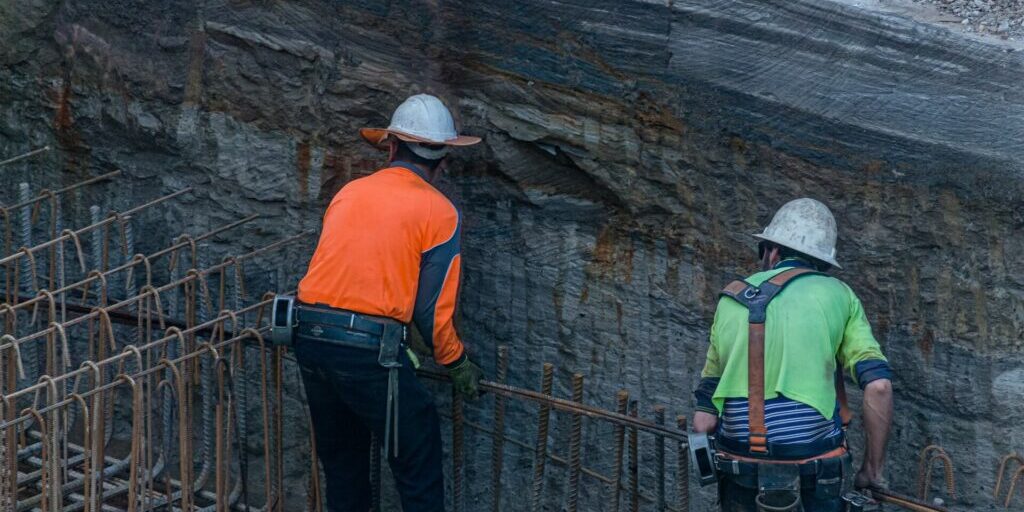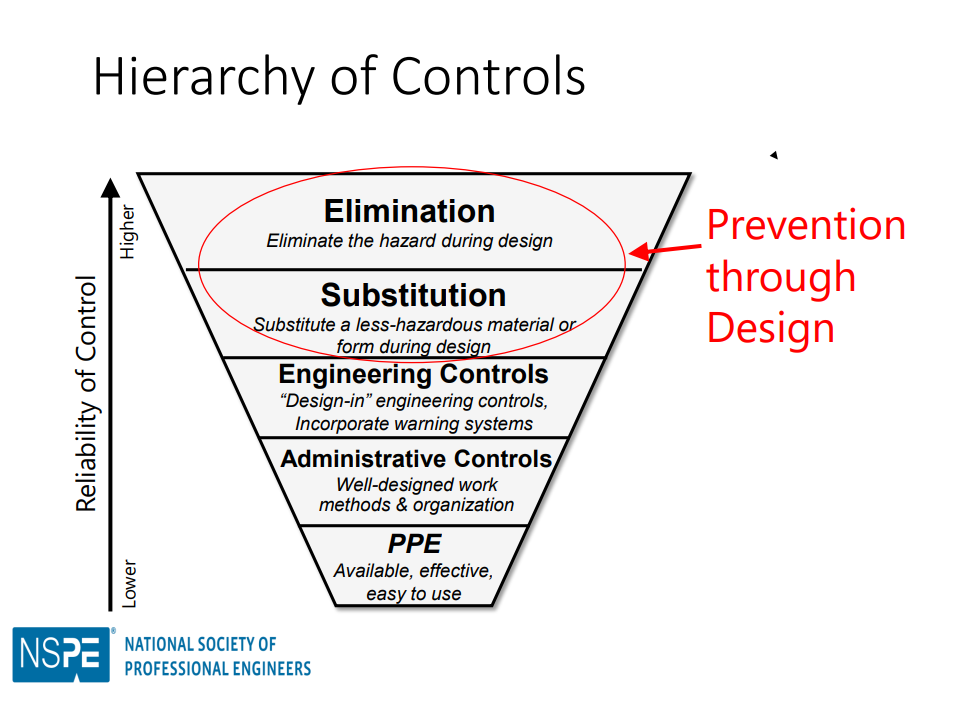Construction Safety by Design: Improving the Hierarchy of Controls

Improvements to construction safety have been slow in coming.
Before the Federal Employees’ Compensation Act of 1916, employers had no financial incentive to protect their workforce. As a result, safety on the job site was primarily the worker’s responsibility.
It would take almost two decades for that attitude to change when Joseph Strauss, Chief Engineer on San Francisco’s Golden Gate Bridge, insisted on rigid safety standards during the construction of his project.
Strauss, an engineer, implemented physical controls to isolate workers from the hazards of bridge construction. These engineered controls included the famous safety net and safety lines. He also insisted that workers wear personal protection equipment (PPE), such as hard hats, respirators, glare-free safety goggles, and protective gloves.
Strauss’s contributions to construction safety are admirable but incomplete.
Here’s what we cover:
- The hierarchy of controls in construction safety
- The Hierarchy of Controls Revisited: Better construction safety by design
- Barriers to Prevention through Design for better construction safety
- Leveraging technology to improve construction safety
- Scheduling construction safety measures into the project
- Construction safety is no accident
The hierarchy of controls in construction safety
Nearly twenty years later, in the early 1950s, the National Safety Council introduced a systematic approach to safety known as the Hierarchy of Hazard Controls.
The hierarchy of controls proposed that designing safe structures and eliminating risks and hazardous conditions before construction is the most effective way to protect workers and the environment.
“Hierarchy of Controls.” U.S. National Institute for Occupational Safety and Health.
Elimination
In modern construction, elimination could be using off-site or modular construction to avoid risky job site conditions such as heights and unstable work surfaces.
Instead of constructing an entire structure on-site, workers build individual sections of the structure in safe and controlled environments. These modules are then transported to the construction site and placed with cranes to complete the building project.
If elimination isn’t possible, the next effective method is to choose a suitable replacement or substitution.
Substitution
Substitutions can be in either methods or materials.
For instance, directional boring is often safer than trenching, and using non-hazardous materials is better for workers and the environment than using their hazardous counterparts.
Engineering controls
Engineering controls don’t eliminate construction hazards, but they protect workers from danger by providing a physical barrier between the risk, or risky situation, and the worker.
Engineered control includes work platforms, temporary walls, temporary lighting, protected walkways, safety railings, and remote-controlled equipment.
Administrative controls
Safety training, warning signage, and Material Safety Data Sheets (MSDS) are examples of administrative controls. Administrative controls change how people work and interact with hazardous materials and construction methods.
While helpful, administrative controls are still less effective than elimination, substitution, or engineering controls and tend to be more costly.
Administrative controls rely on human intervention and constant supervision, and because of that, administrative controls are more prone to human error and failure.
Personal protective equipment (PPE)
The final and least effective line of defense in construction safety is personal protective equipment (PPE).
PPE does provide an element of protection, but personal protective equipment like harnesses, coveralls, and Nomex suits can also hinder movement, putting workers at risk.
Safety glasses and face shields obscure visibility, and ear plugs and protective headphones prevent workers from hearing each other and the sirens and warning alarms that could protect them from danger.
The Hierarchy of Controls Revisited: Better construction safety by design
As we’ve seen, workforce safety has traditionally been the workers’ responsibility. Eventually, the government intervened and transferred the safety liability to the construction firms contracted to perform the work.
However, as we’ve noted, because individual workers and the firms contracted to perform the work can only deploy engineering, administrative, and PPE controls, practical safety measures on the construction site are still elusive.
Construction workers and the firms that employ them still have little control over creating a safe and equitable working environment.
Recognizing this and the need for better safety in the workplace, the United States National Institute for Occupational Health and Safety (NIOHS) and the Centers for Disease Control and Prevention (CDC) began promoting Prevention through Design (PtD) in 2007.
The Prevention through Design (PtD) initiative encourages greater concentration on hazard elimination and substitution where it is most effective–in the design phase.

For instance, we know that it’s far less expensive and less risky to make changes to a design than to make changes to the built environment.
Couple that with the strong correlation between re-work and higher instances of injury and death, and the case for Prevention through Design is even more relevant.
Furthermore, research finds that up to 47% of worksite injuries and fatalities during construction can be traced back to features that could have been eliminated or improved during the design phase.
The Prevention through Design initiative also emphasizes safety throughout the built environment’s entire lifecycle.
That means PtD looks beyond the project delivery phase and commissioning for potential risks associated with ongoing maintenance.
By eliminating or designing out elements that may prove risky to construct and maintain, the Prevention through Design philosophy shows promise of drastically reducing workplace injuries and fatalities.
Barriers to Prevention through Design for better construction safety
As with most things new in the construction industry, widespread adoption of Prevention through Design has been slow.
There is still a great divide between design teams and the construction firms who bring those designs to fruition.
- Designers fear potential liability and have limited experience with PtD methods.
- Competing priorities: Safety vs. cost/schedule/aesthetics.
- Building Information Modeling (BIM), useful in PtD, requires extensive training and is costly to implement.
- Designers see no financial advantage to implementing PtD–at least not yet.
Leveraging technology to improve construction safety
Until the construction industry makes Prevention through Design the standard, construction firms can leverage the technology at their fingertips to create safer, more productive work environments.
Construction management software makes this possible.
Scheduling construction safety measures into the project
Construction firms of all sizes rely on their schedules to keep their projects on track.
Scheduling time each day to properly stage the work site for worker safety must become standard operating procedure.
Cloud-based scheduling platforms make this easy.
Mobile app verifications
Everyone on the construction site has technology in their pocket or within reach. And many construction firms use mobile technology to monitor and manage their workforce.
Simply requiring workers to snap a photo of their work zone at the beginning of each shift would provide ongoing feedback on what safety measures are in place and what more is required.
Administrative controls
In addition to scheduling time to install and maintain safety measures, you can also take advantage of construction management software in other ways.
- Schedule regular breaks.
- Ensure only trained personnel are assigned to specific tasks
- Monitor time spent in hazardous work zones and rotate assignments as required.
- Train new hires in safe work processes with visual guidance in the mobile app.
Ensure employees don’t lose focus or make mistakes due to mental and physical fatigue.
Monitor production while encouraging proactive safety practices with mobile updates and feedback in real-time.
Online construction safety training
Construction management software built on open API connects your workforce with construction safety resources like toolbox talks and ongoing safety training.
This convenience makes ongoing safety training available wherever your employees are: on-site, in the job trailer, or at your office.
Construction safety is no accident
Contact your Linarc representative today and see how cloud-based software built for construction can help you take a proactive approach to your construction safety program.




